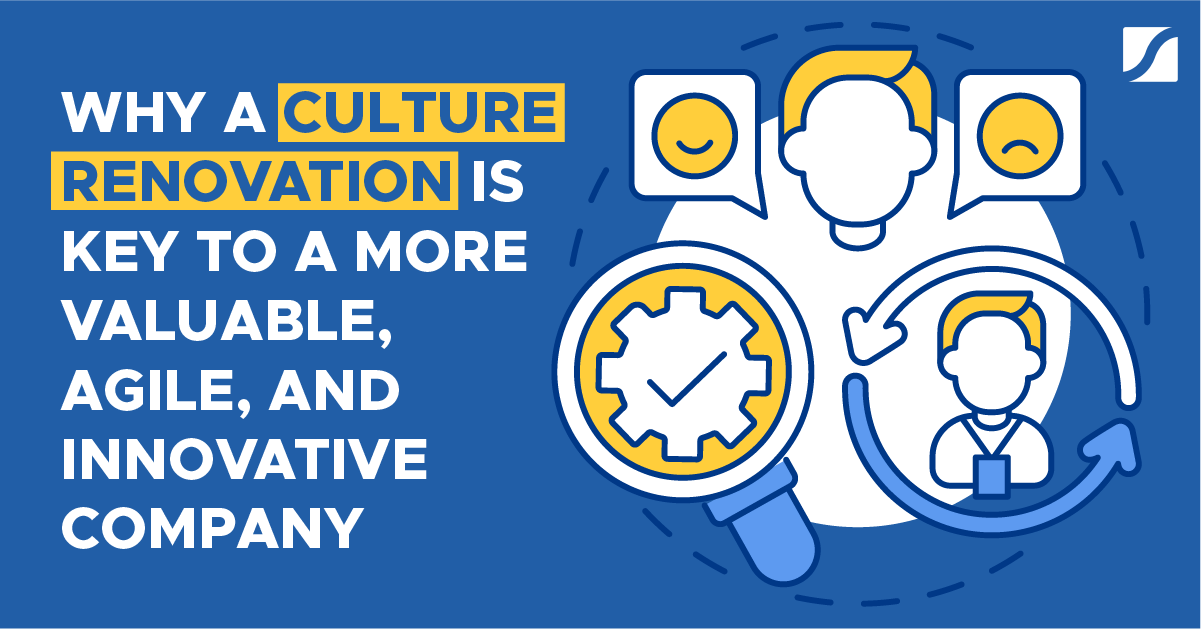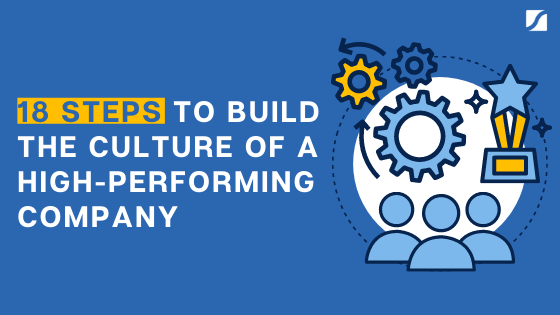The 3 Phases To Know If You Want Your Company’s Culture Renovation To Work
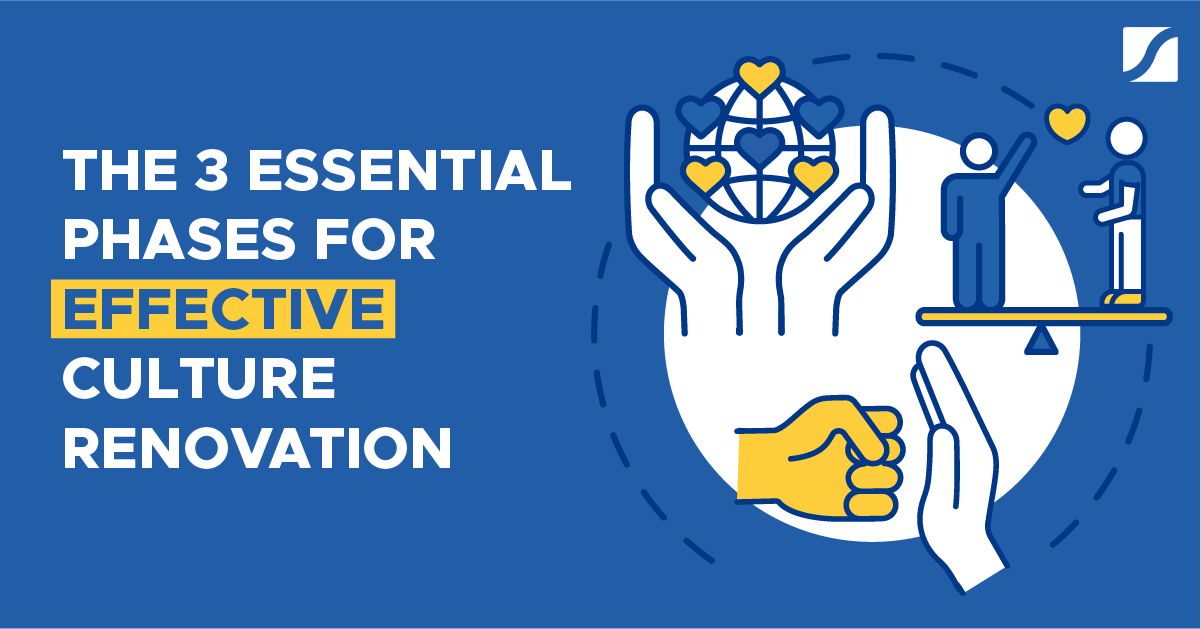
renova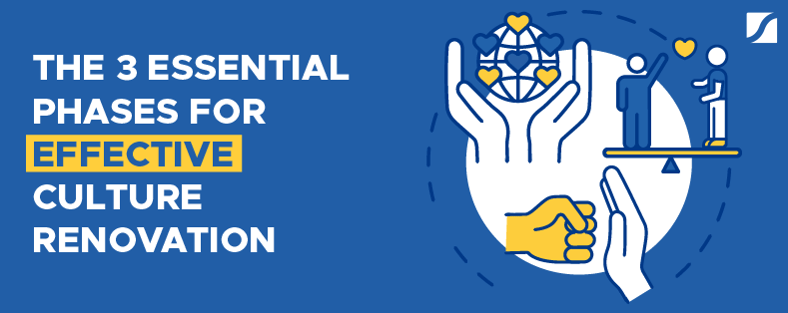
Every good leader knows that a healthy culture is critical to their company’s success.
It’s no surprise then that culture change is a priority for executives today - at companies large and small. However, this is a big undertaking. Many attempt to transform their culture by completely overhauling it. And most fail.
The best way to improve your culture is by keeping what’s unique and hard to replace and renovating the rest.
Kevin Oakes is the CEO of i4cp, a leading research firm focused on uncovering insights in human capital next practices.
By pouring through thousands of company case studies and interviews with executives all over the world, i4cp were able to distill the specific leadership actions that build an enduring company culture.
Kevin’s book, Culture Renovation®: 18 Leadership Actions to Build an Unshakeable Company, demonstrates how these actions can be split up into 3 phases to follow as you renovate your culture, which I'll summarize here.
Why Care About Renovating Your Company Culture?
Only a decade ago, companies like Exxon Mobil, Shell Corporation and General Electric dominated the top 5 slots of the most valuable companies. 
Today, only one of those companies remains on the list: Microsoft.
It’s a telling signal of how thoroughly disruption affects the market these days - and how quickly market leaders can be replaced.
How companies view and respond to disruption is heavily reflected in their cultures.
For example, i4cp’s research found that high performance organizations are 3X more likely to see market changes as an opportunity to shake things up. On the other hand, lower performing organizations are 3.5X more likely to see change as bad for business.
How do your employees describe the changes that go on inside and outside of your company? Do they perceive it as overwhelming or destabilizing to what they normally do? Or would they say that it’s normal and just a part of your business model; a chance to think outside the box?
As a leader in your company, it’s your responsibility to enable your business to more quickly and effectively see change coming and adapt to it.
Like it or not, any major change in your business or strategy is likely doomed unless your company’s culture and people embrace it and reflect it moving forward.
What Does A Healthy Company Culture Look Like?
Research shows that company culture correlates to market performance.
If a company performs great in the marketplace, it likely happened because of their culture.
If you want to lay the foundation for success in the market, research shows that putting your culture through a renovation process is the easiest path.
ic4p’s research into hundreds of areas of human capital and an organization’s market performance supports the hypothesis.
The data also revealed that top-performing companies have a few culture traits in common. This came out of a survey of 7,662 business professionals globally, who were asked to rate their own organization’s culture.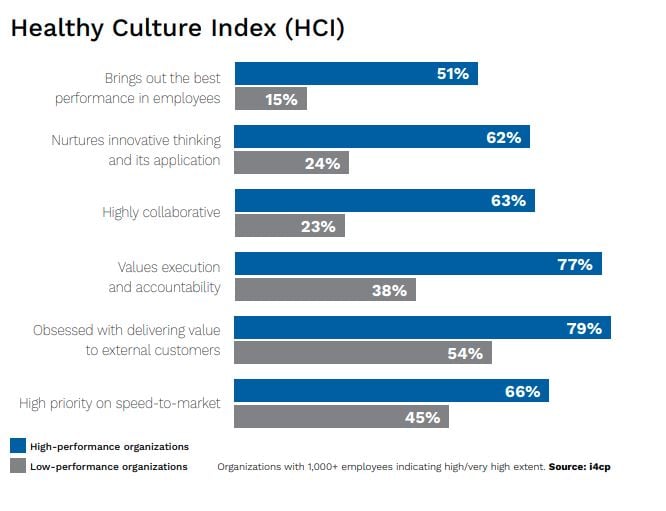
Together, these 6 elements form the foundation of a healthy organizational culture.
- Brings out the best performance in employees
- Nurtures innovative thinking and its application
- Highly collaborative
- Values execution and accountability
- Obsessed with delivering value to external customers
- High priority on speed to market
While most companies would love it if employees describe their culture with these traits, the reality is that few companies excel at all of them. Culture change is hard. i4cp's work found that only 15% of companies declare that they have successfully changed their culture!
But the research uncovered a silver lining. Of that 15 percent of companies that succeeded, clear patterns emerged on why their culture change was successful. First, they renovated their culture rather than completely transforming it. Second, they took specific actions that helped their culture renovation initiative succeed.
These actions can be divided equally into 3 major phases that serve as a blueprint for your culture renovation efforts: Plan, Build, and Maintain.
Here are the 3 phases broken down and some sample actions to get started today.
Phase 1: Plan
Set the foundation for your successful culture renovation by researching the state of your culture as it is today.
With that information gathered, you’ll then be able to better identify which elements to keep and which ones to discard; the key people you’ll rely on to help drive the effort; and how you’ll track your progress.
Sample Actions For The Plan Phase:
Develop And Deploy A Listening Strategy
The most successful companies in the study first gathered sentiment and related data from their workforce.
They wanted to understand how employees viewed the existing culture and use that information to figure out what the new culture should be.
The best thing you can do is listen to your customers and employees. For best results, use technology and multiple channels to get a more accurate picture.
Then, act on what you hear, no matter how much it counters to how you’ve done things in the past.
Figure Out What to Keep
An important step in renovating anything - whether it’s your kitchen or your entire company - is understanding what stays and what goes.
With the sentiment you gathered in the previous step, you’ll have a much better idea of what the most valued aspects of your company's culture and history are - and which ones you can get rid of.
Identify Influencers, Energizers and Blockers
Network science shows that certain people in every workforce have greater social influence than others.
Every company has “go-to” people who peers turn to for answers, opinions, and guidance. These influencers and energizers are everywhere and it’s actually rare that senior leadership are aware of them.
Through formal and informal network analysis techniques, you can identify these potential “culture ambassadors”. This can be done through a simple survey or by analyzing interactions on your internal communications (places like e-mail, Slack, Teams, etc.).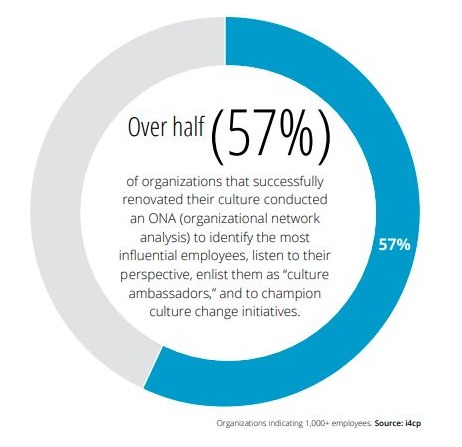
Once you know who these influencers are, you can then ensure they understand and are on-board with renovation efforts. 
Phase 2: Build
A successful culture renovation doesn’t happen overnight.
It’s like renovating a house or overhauling the makeup of a centuries old organization. It will never go completely as planned. It’s a process that takes optimism, patience, and perseverance.
Once the excitement of the launch wears off, you need an execution strategy in place that builds and sustains the momentum.
Sample Actions For The Build Phase:
Communicate That Change Is Coming
The research found that almost 80 percent of organizations that were successful at culture renovation had a lead architect who led the change.
In almost all cases, that lead architect was the CEO.
When communicating the culture change, it’s critical that this message comes consistently and frequently from the very top. It also needs to be clear.
When first kicking off the culture renovation, the CEO should articulate the purpose of the organization. This purpose should resonate with employees and should be instilled with the spirit of renovation: acknowledge and respect the past while building for the future.
Your employees should be able to understand what the culture initiative aims to change, what the future looks like, and why this change is so vital to the success of the business.
Ferret Out Skeptics and Nonbelievers Early
This will probably be the hardest part of your culture renovation.
Intuitively, the necessity of this step makes sense. For the culture initiative to be successful, it’s important to make sure that the skeptics and the doubters are not a part of it.
The research into the successful organizations uncovered this as well. Almost 40 percent of them made sure that non-believers and blockers were either convinced of the change's merits or decisively moved out of the organization.
Establish a Co-creation Mindset
Though the culture change needs to start - and be communicated - from the top, you also still need to get buy-in from your employees.
Successful companies enlist, align, and empower the workforce at all levels of the organization in the renovation effort. They crowdsource ideas to ensure that most feel they had a hand in developing and executing on the change initiative.
Make sure that your employees don’t just see this as a top-down change. Rather, make sure that everyone has a say in developing the newly renovated culture.
Phase 3: Maintain
Changes to other talent management practices—such as performance management, onboarding, mobility, and succession—help reinforce and maintain the new culture, as does monitoring sentiment and promoting stories.
Sample Actions For The Maintain Phase:
Promote Those Who Best Represent The New
You want to maintain what you’ve built - and avoid falling back to your old standards.
So it’s important that your employees understand that behaviors that support the renovated culture will get rewarded.
One of best ways to do this is to showcase the career advancement of the people who best “represent the new”. Ideally, these are the individuals who have the traits that best embody the renovated culture, champion it, and are capable of expanding efforts that you initiated in the build phase.
Change Performance Management Practices
Performance management is a ubiquitous and favorite topic of HR professionals.
When done right, it reinforces the culture and can make an organization incredibly efficient, transparent, and successful. But it’s also one of the most overhauled of the HR processes. And when done wrong, it can seriously weaken an otherwise strong business.
Companies have found varied success with different performance ranking systems. Jack Welch used force ranking at GE to “thin the herd.” In the 1990s, self-appraisals and 360-degree feedback grew popular. The latest trend abolishes ratings altogether in favor of ongoing managerial feedback and coaching. Companies like Adobe, Deloitte and Microsoft have been proponents of this system.
Despite extensive expert coverage, there is no magic bullet for performance management systems. It’s highly dependent on the company and culture within which it is applied.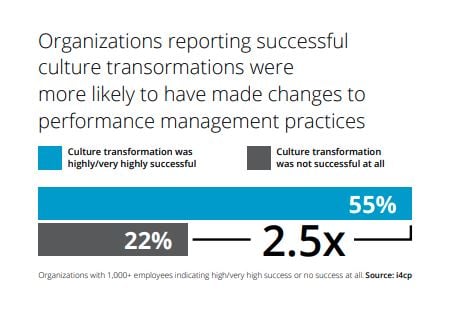
In your case, make sure that the way in which you measure performance aligns with the behaviors you want to enforce in your post-renovation company.
Increase The Focus On Talent Mobility
In your culture renovation efforts, employee resources groups (or ERGs) are important.
i4cp studies have shown that they help support a more diverse and inclusive workplace, develop future leaders, and enhance engagement. They can also help you drive and maintain the new culture by helping you learn more about various employee groups throughout the organization. By leveraging the members of these groups, you can bring on culture ambassadors to promote and reinforce the new culture to the rest of the organization.
These groups will also be a great source for identifying new leaders for your company, as they are very effective at developing leadership skills and competencies.
Conclusion
The state of your culture significantly impacts both internal and external company performance. So it makes sense that you and your leadership team should prioritize its health.
The key things to remember when taking these action steps are simple. Culture change is hard, ongoing, and yet entirely possible. Support and leadership from the top are critical to culture change success.
Above all, it’s a process that takes commitment and ongoing applied innovation.


